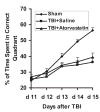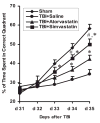Statins increase neurogenesis in the dentate gyrus, reduce delayed neuronal death in the hippocampal CA3 region, and improve spatial learning in rat after traumatic brain injury
- PMID: 17610353
- PMCID: PMC1971229
- DOI: 10.1089/neu.2007.0288
Statins increase neurogenesis in the dentate gyrus, reduce delayed neuronal death in the hippocampal CA3 region, and improve spatial learning in rat after traumatic brain injury
Abstract
Traumatic brain injury (TBI) remains a major public health problem globally. Presently, there is no way to restore cognitive deficits caused by TBI. In this study, we seek to evaluate the effect of statins (simvastatin and atorvastatin) on the spatial learning and neurogenesis in rats subjected to controlled cortical impact. Rats were treated with atorvastatin and simvastatin 1 day after TBI and daily for 14 days. Morris water maze tests were performed during weeks 2 and 5 after TBI. Bromodeoxyuridine (BrdU; 50 mg/kg) was intraperitoneally injected 1 day after TBI and daily for 14 days. Brain tissue was processed for immunohistochemical staining to identify newly generated cells and vessels. Our data show that (1) treatment of TBI with statins improves spatial learning on days 31-35 after onset of TBI; (2) in the non-neurogenic region of the hippocampal CA3 region, statin treatment reduces the neuronal loss after TBI, demonstrating the neuroprotective effect of statins; (3) in the neurogenic region of the dentate gyrus, treatment of TBI with statins enhances neurogenesis; (4) statin treatment augments TBI-induced angiogenesis; and (5) treatment with simvastatin at the same dose provides a therapeutic effect superior to treatment with atorvastatin. These results suggest that statins may be candidates for treatment of TBI.
Figures







Similar articles
-
Enhanced hippocampal neurogenesis by intraventricular S100B infusion is associated with improved cognitive recovery after traumatic brain injury.J Neurotrauma. 2005 Jun;22(6):645-55. doi: 10.1089/neu.2005.22.645. J Neurotrauma. 2005. PMID: 15941374
-
Simvastatin and atorvastatin improve behavioral outcome, reduce hippocampal degeneration, and improve cerebral blood flow after experimental traumatic brain injury.Exp Neurol. 2007 Jul;206(1):59-69. doi: 10.1016/j.expneurol.2007.03.031. Epub 2007 Apr 27. Exp Neurol. 2007. PMID: 17521631
-
Effects of atorvastatin in the regulation of circulating EPCs and angiogenesis in traumatic brain injury in rats.J Neurol Sci. 2012 Aug 15;319(1-2):117-23. doi: 10.1016/j.jns.2012.04.015. Epub 2012 Jun 2. J Neurol Sci. 2012. PMID: 22658532
-
Forebrain neurogenesis after focal Ischemic and traumatic brain injury.Neurobiol Dis. 2010 Feb;37(2):267-74. doi: 10.1016/j.nbd.2009.11.002. Epub 2009 Nov 10. Neurobiol Dis. 2010. PMID: 19909815 Free PMC article. Review.
-
Is there a link between adult neurogenesis and learning?Hippocampus. 2006;16(3):216-24. doi: 10.1002/hipo.20153. Hippocampus. 2006. PMID: 16421862 Review.
Cited by
-
Effects of over-expression of HIF-1alpha in bone marrow-derived mesenchymal stem cells on traumatic brain injury.Eng Life Sci. 2018 Apr 14;18(6):401-407. doi: 10.1002/elsc.201800015. eCollection 2018 Jun. Eng Life Sci. 2018. PMID: 32624920 Free PMC article.
-
Atorvastatin May Attenuate Recurrence of Chronic Subdural Hematoma.Front Neurosci. 2016 Jun 28;10:303. doi: 10.3389/fnins.2016.00303. eCollection 2016. Front Neurosci. 2016. Retraction in: Front Neurosci. 2016 Oct 07;10:465. doi: 10.3389/fnins.2016.00465. PMID: 27445673 Free PMC article. Retracted.
-
The ROCK/GGTase Pathway Are Essential to the Proliferation and Differentiation of Neural Stem Cells Mediated by Simvastatin.J Mol Neurosci. 2016 Dec;60(4):474-485. doi: 10.1007/s12031-016-0811-y. Epub 2016 Aug 19. J Mol Neurosci. 2016. PMID: 27541019
-
Combination therapies for neurobehavioral and cognitive recovery after experimental traumatic brain injury: Is more better?Prog Neurobiol. 2016 Jul;142:45-67. doi: 10.1016/j.pneurobio.2016.05.002. Epub 2016 May 7. Prog Neurobiol. 2016. PMID: 27166858 Free PMC article. Review.
-
Atorvastatin in stroke: a review of SPARCL and subgroup analysis.Vasc Health Risk Manag. 2010 Apr 15;6:229-36. doi: 10.2147/vhrm.s6795. Vasc Health Risk Manag. 2010. PMID: 20407630 Free PMC article.
References
-
- Becher A, Drenckhahn A, Pahner I, Ahnert-Hilger G. The synaptophysin–synaptobrevin complex is developmentally upregulated in cultivated neurons but is absent in neuroendocrine cells. Eur J Cell Biol. 1999;78:650–656. - PubMed
-
- Chen J, Zhang ZG, Li Y, et al. Statins induce angiogenesis, neurogenesis, and synaptogenesis after stroke. Ann Neurol. 2003;53:743–751. - PubMed
-
- Consensus Conference. Rehabilitation of persons with traumatic brain injury. NIH Consensus Development Panel on Rehabilitation of Persons with Traumatic Brain Injury. JAMA. 1999;282:974–983. - PubMed
-
- Davidson MH, Ballantyne CM, Kerzner B, et al. Efficacy and safety of ezetimibe coadministered with statins: randomised, placebo-controlled, blinded experience in 2382 patients with primary hypercholesterolemia. Int J Clin Pract. 2004;58:746–755. - PubMed
Publication types
MeSH terms
Substances
Grants and funding
LinkOut - more resources
Full Text Sources
Medical
Miscellaneous

